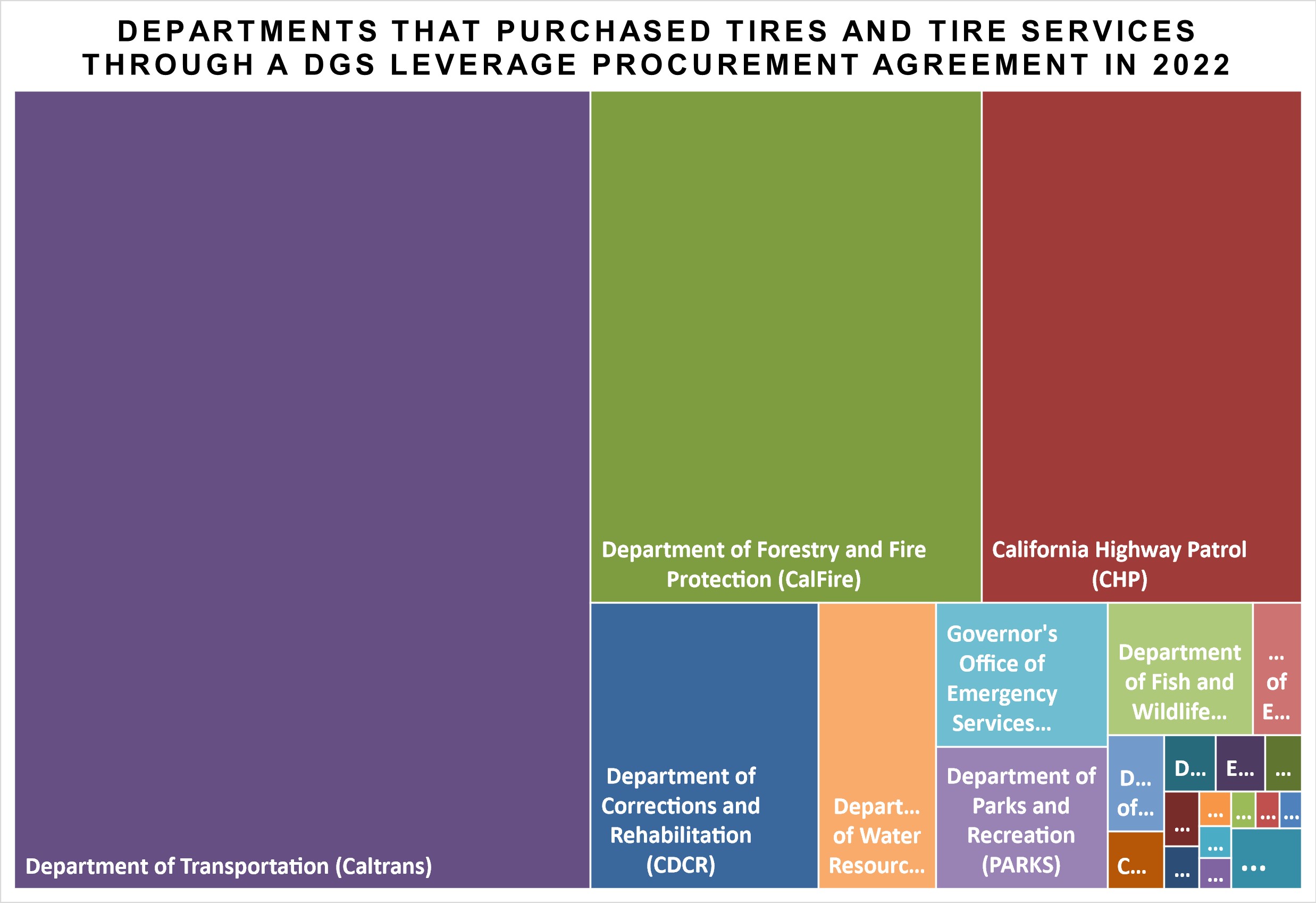Get a Tighter Grip on the Road with Low Rolling Resistance Tires

The state of California encourages purchases that save money, reduce harmful emissions, and increase fuel efficiency. Tires are an important part of any state vehicle's fuel efficiency. The state of California encourages the purchase of low-rolling-resistance tires for fuel efficiency, which may not be offered by traditional standard tires for fleet vehicles purchased previously.
The cost of gas has risen steadily over the years. Fuel savings can add up over time, especially if you choose original equipment manufacturer (OEM) recommended tread wear tires. To learn more about these options and other ways to reduce your carbon footprint, visit the Buying Green Guide. Once there, select Transportation then Tires. Expand Green Contracts to view tire contracts offered for various vehicle types.
 Overview of State Spend
Overview of State Spend
The table below shows a breakdown of data, by department. Total annual purchases of tires and tire services are estimated to be $5,593,741 in 2022.
|
State Departments |
Total Spend by Department on Tires and Tire Services |
|
Department of Transportation (Caltrans) |
$2,503,517 |
|
Department of Forestry and Fire Protection (CalFire) |
$1,090,616 |
|
California Highway Patrol (CHP) |
$892,115 |
|
Department of Corrections and Rehabilitation (CDCR) |
$355,164 |
|
Department of Water Resources |
$183,254 |
|
Governor's Office of Emergency Services (CalOES) |
$134,163 |
|
Department of Parks and Recreation (PARKS) |
$132,374 |
|
Department of Fish and Wildlife (CDFW) |
$104,510 |
|
Department of Education |
$35,344 |
|
Department of General Services (DGS) |
$29,795 |
|
California Conservation Corps (CCC) |
$17,615 |
|
Department of Public Health (CDPH) |
$15,937 |
|
Emergency Medical Services Authority (EMSA) |
$15,223 |
|
Department of Food and Agriculture (CDFA) |
$11,286 |
|
Department of Veterans Affairs (CalVet) |
$10,450 |
|
Department of Consumer Affairs (DCA) |
$8,010 |
|
Department of Motor Vehicles (DMV) |
$5,963 |
|
Department of Resources Recycling and Recovery (CalRecycle) |
$5,549 |
|
Department of Justice (DOJ) |
$5,342 |
|
California Military Department (CalGuard) |
$4,878 |
|
Department of State Hospitals |
$4,875 |
|
Franchise Tax Board |
$4,418 |
|
Department of Insurance (CDI) |
$3,882 |
|
California Tahoe Conservancy |
$2,994 |
|
Department of Toxic Substances Control (DTSC) |
$2,748 |
|
California Lottery (CALottery) |
$2,439 |
|
California Exposition and State Fair (CAL EXPO) |
$1,856 |
|
Employment Development Department (EDD) |
$1,507 |
|
Department of Health Care Services (HCS) |
$1,386 |
|
Department of Cannabis Control |
$1,194 |
|
State Controller's Office (SCO) |
$1,068 |
|
Department of Industrial Relations (DIR) |
$870 |
|
Department of Developmental Services |
$739 |
|
California State Lands Commission |
$711 |
|
Department of Health Care Access and Information |
$672 |
|
Department of Pesticide Regulation (DPR) |
$650 |
|
Department of Toxic Substances Control (DTSC) |
$630 |
|
2022 Total Spend on Tires and Tire Services |
$5,593,741 |
|
Source: DGS 2022 Usage Reports
|
|

Buy Wisely
|
Why Buy Green? |
Here are some tips to help you make the best purchase for your state department when it comes to tires. |
|
Fleet managers and drivers can reduce vehicle related costs and minimize carbon footprints by implementing fuel- efficient equipment designed to save fuel.
Implementing these systems will allow your department to better manage their vehicles. Such strategies are cost-efficient and do not require extended vehicle down-time. |
|

The California Procurement and Contracting Academy (CalPCA) has developed training modules to help requisitioners, buyers, supervisors and managers buy green with ease. These training programs assist procurement officials by introducing the criteria that can be used while purchasing goods and services to increase EPP within a department.
To participate in online self-paced training, register free here.
The EPP BASIC training will cover:
- Third-Party Environmental Certifications verify processes that validate the relevant environmental claims and the product’s performance. They are referred to as eco-labels, green labels, or sustainability certifications. The training will introduce you to how to identify approved certifications and labels.
- The DGS Purchasing Standards list the minimum performance and environmental criteria a commodity must meet to be considered environmentally preferable. This training will show you the standards that can be used within your own procurement contracts.
- SABRC-compliant products meet the minimum post-consumer recycled content requirements for that category. In addition, the training will cover why it is essential for departments to report all goods and materials within the SABRC category.
- Product Take-Back Program refers to the process through which a manufacturer, retailer or third-party designee takes back the products at the end of their useful life for recycling, remanufacturing, repurposing or proper disposal consistent with environmental laws and regulations.
- Greenwashing is when incorrect information by an organization appears environmentally responsible. We will show you examples in the training so that you are able to identify EPP goods.
Who should participate?
- Purchasers
- Purchasing Authority Contacts (PACs)
- Procurement and Contracting Officers (PCOs)
- Small Business/Disabled Veteran Business Enterprise (SB/DVBE) Advocates
- Supervisors and managers
- Executives
DGS has developed job aids to help simplify buying green. The EPP and FI$Cal job aids together comprise a comprehensive “how-to” manual that provides detailed instructions on how to apply EPP to purchases and consists of the following documents:
